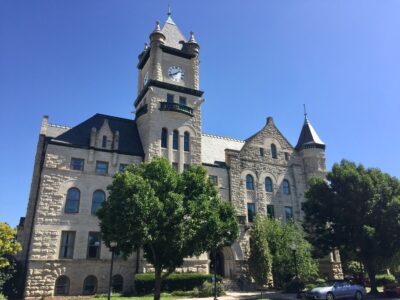Sustainability leaders say Douglas County is reducing its energy consumption and will soon help residents do the same

photo by: Screenshot
Douglas County commissioners met for a work session on Wednesday, February 20, 2025.
Jamie Hofling, Douglas County’s sustainability impact analyst, says the county has “work to do to reduce our own energy consumption” — but she also says the county has made a lot of progress so far.
There’s the LED lighting in facilities that’s expected to save thousands of dollars annually and last 15 years. There are solar panels on some county buildings that could offset their energy consumption by a third. And, soon, there will be a new “community energy hub” where county residents can learn about ways they, too, can save money and reduce their energy use.
Hofling updated county leaders about the county’s sustainability initiatives during a work session ahead of the County Commission’s meeting on Wednesday. She and other staff from the county’s sustainability department said that increasing renewable energy and energy efficiency in local government and institutional facilities was important if the county wanted to lower its greenhouse gas emissions, as stated in the countywide climate action and adaptation plan.
Hofling said the county’s sustainability staff has looked at several ways to improve buildings’ energy impact. At the Extension Office on the Douglas County Fairgrounds, the lighting has been upgraded to use LEDs, and the same thing is being done for Public Works.
“Once those are implemented, that will save us about $15,000 annually,” Hofling said. “And those lights are expected to last for 15 years.”
Hofling also told commissioners that solar panels have been added to some county buildings, “helping to offset one-third of what we’re anticipating those buildings to consume on energy.”
But it’s not just county facilities that the team wants to improve. They’re currently working on establishing an online community energy hub where residents can find tools and resources for reducing their own energy use.
With the hub, the hope is that “Douglas County residents, businesses and nonprofits can learn and easily access information about financial incentives that will help them reduce their own energy consumption and therefore, save money,” Hofling said. “That’s something that will be coming out very soon.”
The sustainability staff is looking into tackling other projects as well. In order to have a better understanding of what’s in Douglas County’s waste stream, local sustainability leaders also expressed interest in updating the county’s waste management plan, a comprehensive document outlining a community’s strategy for collecting, treating and disposing of solid waste. Additionally, it includes goals for reducing waste generation and managing disposal practices to protect human health and the environment. The plan hasn’t been updated since 1996.
Historically, this has been a joint plan with Douglas and Jefferson counties. One of the reasons why the plan is in conjunction with another county is because the two share the Hamm Landfill – a 360-acre landfill that serves 13 counties in northeast Kansas – located in Jefferson County.
“Solid waste is a regional concept when you start to consider ultimately where that waste stream is going to,” Deputy County Administrator Sean Pederson said. “That is why you see some of this partnering going on.”
Commissioner Shannon Reid asked how much longer the lifespan of the landfill would be, and County Administrator Sarah Plinsky said she thought the updated plan would have the answer.
Commissioner Erica Anderson also asked about the efforts to expand recycling services to other cities in Douglas County. Plinsky said there have been conversations about more recycling opportunities with the other cities, but she also said it’s an expensive service.
In Lawrence, trash is collected and disposed of by the Solid Waste Division. The trash is taken to landfills and recycling facilities. Recyclables from blue recycling carts are taken to a material recovery facility that is operated by Hamm – which is designed to process 10 tons of single-stream recycling material per hour, according to Hamm’s website.
“I think we want to see expanded recycling,” Plinsky said. “It’s just how we continue to make it affordable for everyone.”







